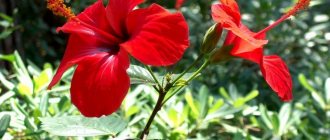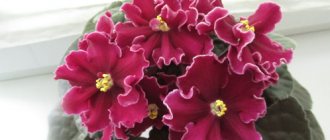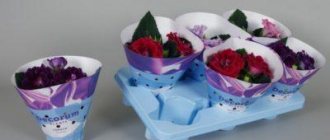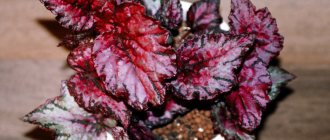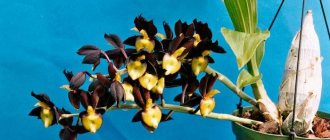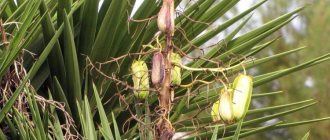Saintpaulias are coming back into fashion and turning the idea of cute blooming violets that willingly live on any windowsill. Trends in the “market” for Uzambara violets indicate a rapid increase in interest in plants with unusual leaves. More and more admiring glances are attracted not by the unusual colors of flowers, but by the exotic variegated colors of the leaves. Variegated Saintpaulias are almost no different from all the others in cultivation. But bright flashes of light spots on the leaves completely transform their appearance.
Saintpaulia 'Rob's Outer Orbit'. © N. Pomazova
What kind of leaves do Saintpaulias have?
Violets are often called indoor plants, the most diverse in terms of flowering parameters and the most boring in terms of greenery. For some reason, all Saintpaulias are perceived as dark-leaved, velvety-leaved, neatly rosette crumbs. But if you take a closer look not only at the flowering, but also at the greenery, it is obvious that each variety’s leaves are actually special.
More rounded or oval, almost heart-shaped or narrow, with a wide base or a narrow petiole, raised or almost recumbent, small, medium and large, with varying degrees of jagged edges, different shades of green color and the effect of their fluffing...
All Saintpaulias are individual and unique. But by “special leaves” of violets they usually mean either plants with ruffles along the edges (beautiful wavy varieties) or newfangled variegated leaves of the selection.
Unlike the extravagant collectible leaf violets, which bloom inconspicuously and are grown only for their leaves, variegated violets are full-fledged and familiar Saintpaulias, in which variegated leaf colors are added to the “option” of luxurious flowering.
Saintpaulia 'Lucky Penny'. © Mildred Rosam
Classification and popular varieties of indoor violets (Saintpaulia)
Saintpaulias are divided into:
- Variegated with brightly colored foliage of any shade, with edging. The first varieties had small flowers, later new hybrids with large inflorescences were developed.
- Collectible with voluminous flowers. Almost all of them are terry, with folds. Plates and inflorescences come in various colors. Such Saintpaulias participate in exhibitions and are collected by collectors.
- Industrial, used for large-scale cultivation on special plantations. They are sold wholesale to decorate holidays, offices, and administrative buildings. They do not require special care; they bloom for a long time.
Read more in the article indoor violet or saintpaulia.
By leaf type:
- boy - absolutely green;
- girl - there is a light spot at the base of the upper part;
- lance - elongated, with a pointed end;
- spoon - with edges folded up.
There are also plates:
- smooth, with folds or teeth along the perimeter;
- plain or variegated;
- strongly or weakly pubescent, smooth.
Saintpaulias with inflorescences of different sizes in cm:
- mini (up to 6);
- semi-mini (up to 15);
- medium (20-40);
- large (40-60).
Classification by the number of additional petals:
- semi-double - 1-2 pieces in the middle;
- terry - many, have different arrangements, can be spherical or flat.
There is also a division according to the type of petals:
- Pansies: 2 in the top row, 3 in the bottom. Moreover, the apical ones are smaller.
- Star: equal length, spaced evenly from the center.
- Bell: connected at the base. Because of this feature, Saintpaulia cannot open its inflorescences completely.
- Bowl: unfused, but the plant does not open them completely.
- Wasp: completely disconnected. Two are rolled into a tube, and three are elongated, hanging down.
The size of the bush depends on the substrate: on a nutritious soil mixture, even low-growing Saintpaulias grow to an average size.
There are also Saintpaulia chimeras with a pronounced line of contrasting color on the main background. Such varieties are in demand among collectors.
Lions Pirates Treasures
The buds are pink, with a frame of strawberry shade. Covered with dirty lilac spots and dots. Blistered greens.
Melody Kimi
The foliage is embossed around the perimeter. The flowers are simple. The 2 upper petals are bluish, the rest are cut in the same shade.
Goddess of beauty
Emerald greenery forms a large basal bush. The inflorescences are bright strawberry with a pearlescent amethyst tint.
Austin's smile
The plates form volumetric rosettes. The flowers are star-shaped, single, lilac-coral with a dark purple center and a crimson cut.
EK-Admiral
Flowers in the form of bells, cornflower blue, wavy. The leaves are pointed, dark emerald. They have a creamy pink border around the perimeter.
Robs Dandy Lyon
The inflorescences are large, bell-shaped. Painted in a light green beige tone. The foliage is dark malachite, with light snow-white variegation. Greenery forms rosettes.
Boo Man
Delicate bluish tone. The apical petals are pearly, sometimes greenish. The plates are spoon-shaped, dark emerald.
Ming Dynasty
The flowers are cup-shaped, heavily ruffled, strawberry or lilac in color. Greenery with clearly visible variegation, wavy.
Luna Lily White
The leaves are “quilted” in texture, grassy in color, and form a small basal bush. The inflorescences consist of semi-double snow flowers.
Zemfira
The plates in the middle are variegated. The petals are rolled into lilac tubes with raised folds.
Satellite
The inflorescences are amethyst-scarlet, reach 15 cm. The greens are light green.
Leaf variegation is a unique mutation of Saintpaulias.
Variegated foliage is an atypical phenomenon for Uzambara violets, but it is not exactly an achievement of science. These are natural genetic mutations that reduce the amount of chlorophyll in the cells of certain areas of the leaves and, in fact, disrupt the metabolic changes typical of Saintpaulia.
The possibility of breeding variegated varieties was discovered thanks to an amazing random mutation in one of the largest collections of violets in the United States. Natural mutation remains the main tool for obtaining these unique multi-colored violets today. And selection, which strengthens and enhances variegation in offspring, allows us to obtain different variations of variegated patterns.
The variegation of Saintpaulias - the “value” is not constant. The best variegated varieties in other conditions can completely lose light and colored areas or, conversely, increase their area. Dependence on the quality of care and stability of conditions are the factors that determine the manifestation of this mutation on the leaves of the plant.
Variegated Saintpaulias are attractive because, unlike many other plants, each mutation is completely unique. In fact, variegation is exclusive to each plant. Their leaves can become colored from both the edges and petioles, change patterns throughout the aging process, offer different variations of patterns on each leaf and are not repeated exactly once.
Reasons for the appearance of light spots on leaf plates
Violation of the original varietal color of the leaf, that is, its lightening or the appearance of whitish-yellowish and light brown spots, can occur due to :
- Gross violations of the rules for keeping violets;
- Or insufficient attention to the plant.
The same consequences are possible when a flower is infected with various diseases and pests . Treatment depends on what is causing the spots.
Soil Features
Not all flower growers know why light spots appeared: what to do and where to start. Violets prefer light, very loose soil, with sufficient aeration and water permeability . Good soil specifically for Saintpaulias is best purchased at thematic exhibitions. Experienced specialists can prepare the correct composition, and be sure to check the soil for acidity.
The soil also affects the appearance of spots on violet leaves.
The soil for violets should be close to neutral . A soil environment that is too alkaline or very acidic will not allow the plant to absorb the amount of microelements it needs. Consequently, the chemical balance in the tissues of the flower will be disrupted, which can lead to:
- Change in color of leaf plates;
- Or the appearance of light spots on them.
Feeding with nitrogen, phosphorus and potassium
Why are the leaves light green, what is the reason for this? For comfortable growth and preservation of the decorative nature of the green mass, violets do not require too nutritious soil , since genetically they are accustomed to growing in fairly poor soils.
But, like all house flowers, due to the small volume of flowerpots and the leaching of nutrients with watering, Saintpaulias require fertilizing with mineral fertilizers.
The procedure should be carried out during the active growing season and no more than once a month (visually monitoring the need for feeding).
CAREFULLY! When applying fertilizers, it is necessary to adjust the composition of the nutrient mixture. A significant increase in the concentration of nitrogen in the soil with a simultaneous lack of phosphorus and potassium will certainly lead to overfeeding, loss of immunity and, as a result, to powdery mildew. This means the appearance of light brown spots on the leaves.
Excessive application of potassium fertilizers can lead to an overall yellowing of the plant.
Drafts, sunburn and watering
Why do the leaves become covered with light spots? Quite dense violet leaves react positively to bright lighting, but they also do not tolerate long-term exposure to direct rays of the sun .
Without shading in the summer afternoon hours, burns may appear on the greenery of the flower in the form of yellowish round spots and only on the side facing the window.
This place gradually softens, the spots become light brown, and the leaf cannot perform its functions.
Saintpaulia is a delicate plant in relation to significant movements of air masses and changes in room temperature. In any season it should be protected from drafts, which lead to:
- Cooling;
- Loss of chlorophyll;
- And changes in leaf color (formation of intricate patterns).
Watering violets is carried out in small doses and strictly into the soil or through a drainage hole .
IMPORTANT! Accidental contact with water on the leaf blades causes the formation of spots on them, followed by general yellowing. The use of chlorinated water also has a negative effect.
Diseases
Why do spots appear on leaves? Violets, according to experts, are affected mainly by fungal diseases ; bacterial infections appear on the plant to a much lesser extent.
Spots on violet leaves can appear due to various diseases.
The main disease, which is very dangerous for violets, is expressed by the presence of a white coating , similar to spilled flour. This is powdery mildew, the fungal spores of which penetrate weakened flowers through the soil. In the first stages, the disease causes the formation of light spots, and subsequently can lead to the death of the plant.
Gray rot leads to the growth of grayish spots on the leaves, which darken over time. The death of the leaf in this case cannot be prevented.
Bacterial spots that affect violets are characterized by the presence of a border of a paler tone along the edge of the leaf.
Another disease that leads to leaf discoloration is viral in nature. Its causative agent is the bronzing virus , spread by pests (thrips).
Parasite infestation
Why did the violet leaves turn lighter? There are quite a lot of pests that attack violets and cause the leaves to lighten or spots of light colors to form on them . Among them are:
- Spider and cyclamen mites;
- Thrips;
- Shchitovok;
- Coccid;
- Whitefly;
- aphids;
- And mosquitoes.
All of them suck the juices out of the plant , which leads to the leaves losing their decorative appearance and, in many cases, to death.
Groups of variegated violets
Depending on how the patterns appear not only on individual leaves, but also on the entire rosette, all variegated Saintpaulias are divided into several groups:
- Mosaic varieties (trade name Lilian Jared), in which variegation appears in the center or at the base of the leaf blades in the form of alternating spots, reminiscent of mosaics or marble patterns.
- Bordered varieties (trade name - Tommie Lou) are neat and beautiful Saintpaulias, on the leaves of which light edges appear along the edges and seem to blur, without creating a strict effect.
- Crown varieties (trade name - Champion), in which the variegation decreases from the center of the rosette to its edges, sometimes almost disappearing on the lowest leaves and always appears differently on each leaf - from small specks similar to dust particles to large spots, from rare points until they cover almost the entire leaf plate evenly or cover it completely.
- Chimeric mutations are the appearance of large spots on the leaves of a different shade of green, usually in the center of the leaf.
- Spontaneous mutations occurring in varieties without previously characteristic variegation.
Mutations during vegetative propagation are completely preserved in variegated violets, but with one secret: the cleaner the leaf used for cuttings, the stronger the patterns on the offspring and the stronger the plants themselves.
The most striking variegation in the offspring can be observed if you use non-variegated leaves from the second row in the rosette - from the bottom, of course.
But getting new bushes is not easy: due to mutations, the small, almost white rosettes that form on old leaves during rooting become much more fragile and weaker than those of ordinary Saintpaulias. You can separate them from the cuttings only when they have grown well and dark green colors appear on the young rosettes.
Saintpaulia 'Powwow'. © catfootfog
Variegation varies...
The variegated leaves of violets amaze with their diversity. They can be white-green, yellow-green, slightly brownish, with a delicate pink tint or splashes of beige.
The variegation of violets is divided into 3 types.
1. Crown (Champion). Violets belonging to this group have monochromatic leaves in the lower rows, and variegation appears closer to the top. Moreover, the upper leaves may not be green at all. An interesting point is that as the violet finishes blooming, the variegated streaks on the leaves also disappear and they turn green. Over time, variegation reappears, and new leaves grow variegated. Propagation of violets with crown variegation is carried out by leaf cuttings; their varietal characteristics are perfectly transmitted to children.
2. Bordering, also known as Tommy Lou's variegation, is considered the most decorative and most common. Violets with this type of variegation have green leaves with a clearly defined variegated edge, which can be light yellow, white, brownish, pink or beige. Their rosettes look very elegant even without flowering. These violets are the most unpretentious among their variegated “brothers”. Caring for them is practically no different from ordinary violets with green leaves. Therefore, beginning violet growers should pay attention to varieties belonging to this type.
3. Mosaic (Lilian Jarret) is the most persistent type, all leaves have a stable color. Varieties of violets belonging to this type are the most demanding to care for, and they require increased care and attention. The color of the leaves can be of different shades, the strokes are located throughout the leaf plate. Violets with mosaic variegation do not tolerate hot air very well. Plants with mosaic variegation are found less frequently than representatives of other types.
We should also not forget about chimera violets, whose leaves are very decorative. The leaf blades of chimeras usually have fairly large spots of various shades of green, different from the main one. They can be either darker or lighter, and their boundaries are clearly marked. Such varieties are propagated exclusively by stepsons. Children obtained from leaf cuttings will not repeat the color of the mother plant. Even stepchildren do not always maintain their grade.
Well, no one has canceled spontaneous mutations. Spontaneous variegation appears chaotically, on one, several leaves or throughout the entire plant. Variegated leaves can appear unexpectedly and disappear just as suddenly. It is very exciting to observe such changes.
“Little things” in care that are important for variegated violets
Variegation of leaves means not only decorative changes: the area on violet leaves that is capable of full photosynthesis is also reduced. And the more surface the variegated areas cover, the more the plant depends on the quality of lighting and care.
In general, growing variegated violets is no different from growing all other Saintpaulias. But there are a few things you need to pay attention to if you want to keep your plants healthy and... variegated. After all, this mutation disappears very quickly in an unsuitable environment.
The first thing to do to guarantee variegated patterns is to clarify all the information about the plant when purchasing. At home, variegated Saintpaulias need to recreate the same conditions in which they grew before - otherwise the patterns may disappear. Otherwise, it’s enough to take care of a few nuances:
- Lighting is critical for the plant. Variegated violets will not adapt to change as easily. Only good, diffusely bright lighting with a 12-hour daylight hours guarantees the full development of patterns on the leaves of variegated varieties.
- Temperature requirements for variegated violets change in only one parameter - maximum values. Saintpaulias with variegated leaves do not like heat and will prefer to be in a room with a temperature no higher than 21 degrees.
- It is worth paying attention to one more detail - the quality of the water. Variegated leaves do not forgive mistakes and watering with soft water.
- When choosing fertilizers, you should not use any fertilizers for violets, but only those in which the nitrogen content is reduced compared to potassium and phosphorus.
Saintpaulia 'Rob's Scrumptious'. © Gesneriads
Saintpaulia 'Witch Doctor'. © Mary JI
Saintpaulia 'Alamo Gold Fever'. © Svetlana OS
Variegated varieties of violets. Caring for variegated varieties and their propagation.
There are 3 main types of variegation, which are inherited. The most beautiful of them is the bordering variegated foliage - like Tommy Lowe. In plants of this type, light areas are located evenly along the contour of the leaves, giving a very interesting rosette pattern.
The color of variegated leaves can be white, cream, white-pink, grayish-pink or brown, less often - dark pink or yellow. The intensity of variegation depends on the conditions of maintenance and air temperature. If the plants are sufficiently illuminated and are in a cool room, the variegation becomes brighter and more expressive. If there is not enough light, the leaves become greener, sometimes the variegation disappears completely, more often this happens by the time of flowering.
This type of variegation got its name in honor of violet grower Tommy Lowe Ouden, who in 1959 raised one variegated specimen and observed its hereditary properties over the course of 9 generations. But the plant turned out to be sterile and did not produce seeds. In 1969, violet grower Lyndon Laen managed to obtain seeds from a variegated rosette, from which variegated seedlings emerged, which became the progenitors of all modern variegated varieties.
Crown variegation - when the center of the rosette is painted white, golden or pink, it is more stable and is better inherited.
With this type of variegation, rows of green leaves alternate with colored ones; during flowering, in many varieties, the center of the rosette becomes green.
Mosaic variegation is considered the most stable, when the leaves are partially or completely covered with an irregular pattern, similar to a pattern on marble or a mosaic of pink or cream streaks and spots. This type appeared as a result of a mutation and is rare.
There is another type of variegation - spontaneous. Such plants are not capable of inheriting variegated leaves; the children from their leaves grow up green.
Such variegation occurs as a result of a mutation in the variety or, most often, due to a lack of minerals in the soil, such as manganese and iron, which are responsible for the production of chlorophyll
After transplanting into good soil or fertilizing with nitrogen fertilizers, the variegation completely disappears, the leaves of the plant are colored according to the variety.
Mutated babies with variegated leaves can appear after a sudden change in growing conditions, for example, if the plant grew on a wick and was fed with fertilizer for flowering, but this happens very rarely.
Children from two leaves from a green plant all turned out to be variegated. After replanting, it became noticeable that many of the leaves had an irregular shape. While the plants are under observation, the material will be supplemented over time. The variety – Confrontation (Morev) – has a tendency to such mutations.
Caring for variegated varieties is not much different from caring for ordinary violets. The only difference is that these varieties prefer cooler locations and often enjoy natural light. For successful flowering, they need a daily temperature difference of at least 5-8 degrees. Experimentally, you can determine which varieties need natural daylight and which bloom successfully on the shelf. If a socket on a shelf does not produce buds for 12 months, it means it needs daylight. It is better to keep such varieties on windows and illuminate them for 4-6 hours in winter.
Varieties that fade without problems on the rack are best kept on the lower tiers, where the temperature is slightly lower.
If the leaves of variegated varieties are too light, it is necessary to feed the plants with nitrogen fertilizers. In this case, a weak infusion of mullein or bird manure will restore the amount of chlorophyll and speed up flowering. In the summer, keeping variegated leaves on balconies and loggias, away from direct sunlight, gives good results.
Variegated varieties are propagated in the same way as ordinary ones, by cuttings or stepsons. To do this, you need to choose cuttings with the largest amount of greenery, but not the lowest ones, since you can get a rare and poorly flowering plant. It is advisable to choose cuttings from under the peduncles, this is especially important if the variety is fancy. To do this, it is not at all necessary to remove the peduncle; it is enough to mark the desired cutting and wait until the flowers begin to fade. There is no point in asking the seller to break off the leaf you like; often the owner does not want to spoil the appearance of the plant. Rosettes are usually carefully prepared for exhibitions; there are simply no old and weak leaves. If you definitely want a leaf from under a peduncle you like, come at the end of the exhibition, you might be lucky. If the plant is from your collection, you can plant a leaf from under the first peduncle that appears on the rosette; most often, this is the most beautiful and largest flower.
Children of variegated varieties often appear very light, without greenery.
It is necessary to wait until a sufficient number of green areas appear on the leaves (at least 30%), until then the baby must be left with the mother leaf, otherwise it will die. With sufficient lighting and not the poorest soil, babies appear quite quickly, sometimes within 40 days from planting the cuttings, this happens especially often in miniature varieties.
Sometimes the babies appear completely green, but as they grow, variegation appears.
Variegated leaves pleasantly diversify the collection when other plants are resting, and their flowering is a doubly festive occasion.
The best variegated violets
The first variegated variety among the “mutants” appeared only in 1959, two years after the discovery of the mutation and testing of its stability in the offspring. For a long time, the white border on the leaves was considered something exceptional, and for almost half a century only the very first variegated variety could be found on the shelves, which gave the name to all bordered varieties - “ Lou” .
But in the new millennium, trends quickly changed, and the fashion for everything exotic and unusual also affected the beautiful Saintpaulia crumbs. Here, in Europe, and overseas, dozens of interesting variegated varieties have been actively developed.
The best varieties of violets with variegated foliage rightfully include:
- crown variegated variety 'Private Dancer' with grayish leaves covered with light pink spots, almost completely covering the center of the rosette and purple flowers with thick lilac fringe;
- crown variety 'Rob's Scrumptious' with watercolor transitions of pink to cream and medium green tones on the leaves and candy pink flowers with white edges;
- mosaic variety 'Crabapple' - slow-growing, with five to six shades of green flowing from the brown edge to the whitish center of the leaves and contrasting with the dazzling bright pink double flowers;
- mosaic variety 'Witch Doctor' with huge teeth along the edge of dark green leaves, decorated with cream ornaments and fuchsia-pink double flowers;
- edged variety 'Alamo Gold Fever ' with spreading lines of wavy light edges, white on older leaves and unevenly reddening in the center of the rosette, merging with cream flowers;
- edged variety 'Powwow' with dark scarlet simple flowers and smooth oval emerald leaves, decorated with a powdered border, thicker at the base of the leaf, thin on older leaves and covering almost the entire leaf blade except the “feather” on the rest;
- edged cultivar 'Buckeye Boysenberry' is a lilac, large-flowered, wavy-petaled cultivar whose leaves are adorned with a mottled light pink border;
- one of the darkest-leaved varieties 'Rob's Outer Orbit' with a white-cream “dashed” border, especially pronounced on young leaves and ultramarine flowers, occasionally covered with light pink spots;
- a chimeric cultivar Lucky Penny' with olive green feathery spots on whitish-light leaves and unique faded light lilac flowers that retain dark purple washes in the center of the petals.
Many plants that can be purchased at exhibitions remain nameless, or even just random mutations. But this does not diminish their beauty.
Variegated Saintpaulias - exotic among violets
Saintpaulias are coming back into fashion and turning the idea of cute blooming violets that willingly live on any windowsill. Trends in the “market” for Uzambara violets indicate a rapid increase in interest in plants with unusual leaves. More and more admiring glances are attracted not by the unusual colors of flowers, but by the exotic variegated colors of the leaves. Variegated Saintpaulias are almost no different from all the others in cultivation. But bright flashes of light spots on the leaves completely transform their appearance.
Saintpaulia 'Rob's Outer Orbit'.
© N. Pomazova Contents:
- What kind of leaves do Saintpaulias have?
- Leaf variegation is a unique mutation of Saintpaulias.
- Groups of variegated violets
- “Little things” in care that are important for variegated violets
- The best variegated violets
Fungus
Fungal diseases are a real scourge of violets, and the appearance of spots in this case is far from the worst symptom. Typically, fungus causes characteristic spots: light gray, often covered with fluff. Having removed the mold, you can find plant tissue that has already withered and weakened. Gradually the spots darken and become red when rusting. If a plant is affected by gray mold, most likely this is due to weakened immunity: this usually happens after sunburn or insect damage.
Diseases can appear for various reasons:
- sometimes due to undisinfected soil collected with one’s own hands in the garden;
- lack of important minerals such as potassium and phosphorus;
- excess nitrogen compounds;
- improper care and maintenance.
What to do
If the cause is a fungus, measures must be taken immediately. All affected foliage is cut off - in any case, it will not recover, and moreover, it can become a source of infection for other plants. It is best to isolate a diseased violet altogether, since fungal spores are transmitted quite easily.
After removing the affected parts, treat the surviving plant with a solution of potassium permanganate. In severe cases, you will have to use fungicides and antibiotics.
Advice: if you prepare the soil yourself and do not buy it, be sure to disinfect it. To do this, you need to either heat the soil on a baking sheet in the oven, or scald it with boiling water. This treatment will help get rid of harmful microbes, fungal spores and pest larvae in the garden soil.
Powdery mildew
With this disease, violet leaves become covered with a grayish-white coating, similar to spilled flour. Note that with powdery mildew, plaque can be easily removed by wiping the stain. Plaque can also affect buds, not just leaves.
What to do
Affected parts must be removed and destroyed. For a small lesion, washing the foliage with potassium permanganate will help. But if powdery mildew has seriously affected the plant, use the following drugs:
- Topaz;
- Speed;
- Copper sulfate.
If the disease has already occurred, you should not use prophylactic agents: choose a more potent fungicide.
Tip: when choosing a fungicide, pay attention to its safety class. Products with class 3, no less, are suitable for home use. More toxic drugs can harm apartment residents and pets.
If the fungus has already infected all the leaves, it is better to destroy the flower, since saving it is unprofitable and a positive result is unlikely.
Root rot
If very dark spots appear in the lower part of the plant, damp, wet, gripping, in addition to the leaves, also the cuttings, most likely we are talking about root rot. The disease is dangerous and often leads to the complete death of the flower. The disease occurs due to waterlogging, hypothermia, and it must be dealt with urgently.
What to do
Root rot is much easier to prevent than to treat. Water the violets sparingly, only with warm water and do not allow the plant to overcool. But if rot is an already accomplished fact, we need to begin rehabilitation. Take the plant out of the pot and inspect its roots: as a rule, when the roots are damaged, the violet sits loosely in the ground and comes out of it easily.
If the roots are rotten, they will be dark in color and slimy: healthy ones should be elastic and have a white tint. If the stem is not yet affected, the plant can be saved: cut off the rotten part, treat the remaining part with an antiseptic and replant it in fresh soil. If the stem has already begun to rot, destroy the Saintpaulia - it cannot be saved.
Fusarium
This fungal pathology leads to damage to the roots. From below, the infection spreads to the vegetative part of the plant: brown spots appear on the leaves, and the edges become watery and transparent. Those leaves that are covered with spots die off over time.
Fusarium usually occurs due to keeping Saintpaulia at low temperatures, and sometimes due to a lack of minerals in the soil. Less often, the disease affects the violet after it has bloomed too lush and for a long time: in this case, the plant is greatly weakened.
What to do
Having diagnosed fusarium, isolate the diseased specimen from other plants. Usually the violet cannot be saved: it is destroyed along with the soil in which it grew. It’s also better to throw away the pot, but if it’s a pity, disinfect it thoroughly with strong fungicides and antiseptics.
For preventative purposes, water the plant only with warm water, keep it at the optimal temperature and treat it monthly with a phytosporin solution.



